Duckhorn Portfolio Wine Blog
Posts written by Neil Bernardi, Vice President of Winemaking and many special guest bloggers. This collection of insights on winemaking, farming, entertaining and more is a great way to learn about the excitement of winery life and tips for enjoying the wines we produce.
The 2018 Vintage in Napa Valley
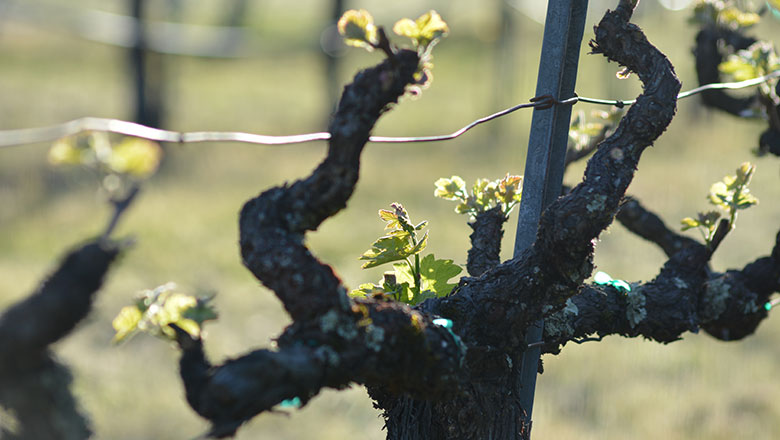
The 2018 vintage was absolutely idyllic and our Napa Valley wines echo a near-perfect growing season. It was one of those years where you sigh with relief because mother nature decided to shine in your favor. Overall, it was a slightly cooler vintage; the winter brought minimal rains, the lowest we had seen in a few years. And as we headed into Spring there were grumbles of another drought, but the rain arrived right on time in March and April. We had a few powerful storms that filled the soil profiles and allowed the vines to wake up from dormancy.
Looking back over my years in viticulture, I see that what is considered “normal” in farming is always changing. That is part of the challenge of viticulture, everything stays the same while absolutely nothing stays the same. You can depend on nothing happening the way you expect it to and in that way that is reliable.
The temperatures in 2018 were cooler than the 2016 and 2017 season and we had moderate to high humidity with comparatively cooler days which contributed to fewer spikes of climactic demand for water (AKA the plant’s demand for water). Water is one of the greatest edges to have in the start of a vintage. It is the difference between coasting through to harvest and having to pay close attention to water demand up until harvest begins.

Budbreak averages in Napa Valley were between March 23rd and April 3rd, about a week later than in 2017. The vineyards took longer to reach full canopy (June 16th as opposed to mid-May of 2017) and they had very little regrowth after hedging and leafing. Bloom began during mid-May in Napa and finished by the beginning of June. Weather during bloom was ideal, it was sunny and warm with a little breeze. When the fruit set, we had very little shatter and had full clusters. Since 2018 was cooler the berries remained small to medium, with great flavor concentration on large rachises.
The summer was mild with temperatures remaining in the high 80’s to the low 90’s, allowing the vines to grow a complete canopy and shift the focus to the fruit without having heatwaves shutting down the plant to conserve water. We had an extended veraison period which was an homage to the cooler year. While slower veraison periods can make me want to pull my hair out, it can be really beneficial to the color and tannin compounds in the grapes. Hang time is always a plus in the right conditions!
The soil water status contributed greatly to delays in bud break, bloom and veraison in 2018. Harvest began about 1-2 weeks later than average and proceeded smoothly. It was a fun harvest year and the ripening of the grapes helped us to have a well-spaced out, less frantic harvest season. Some years we pick non-stop for a month without a break and some years, like 2018, we have the joy of meandering through at each of our estate vineyard sites, including the Paraduxx Rector Creek vineyard.

We had almost an inch of rain October 2nd and hot dry winds mid-October that led to a nice late season with dehydration of fruit which helped usher in the end of the 2018 vintage. The cooler vintage surely had a huge impact on the uniqueness of the wines from this year. 2018 was a rare gem of a vintage in Napa Valley and its ready to be shared with you!
Farming Responsibly
The Vineyard Team here at DWC places a lot of value in being good stewards of the land. In order to try to be as sustainable and eco friendly as we can we follow a program called Integrated Pest Management. This program is a year round system that we implement in order to have a proactive farming plan. The purpose of IPM programs are to eliminate pesticide treatments that are unnecessary, minimize risks to water and air, and to protect beneficial insects as well as pollinators.
Always being educated and aware of the ecosystem around us helps us make conscience decisions for vineyard practices.
Most of our vineyards have also been certified by Fish Friendly Farming. The certification itself is a rigorous process and helps us to maintain and create ideal environmental quality and habitats on private land. Long term environmental improvements and farming sustainably will help us create a better future for farming.
We love our vineyards and taking good care of soil, air, plant and water mean that we can continue to grow amazing grapes year after year while also being the best environmentalists that we can be!

Harvest Over... Now What?
One of the brightest highlights of our year is harvest but once the fruit has been picked there is still a lot to do before we can take a vacation! Right now we are focusing on seeding cover crop in the ground between the vine rows. Cover cropping is important for many reasons. Primarily it is a way that we can reinvigorate the soil with nutrients and organic matter so that we make sure to always have rich, healthy soil. Other reasons for cover cropping are to attract beneficial insects to keep our unwanted pests at bay and to leave less room for weeds to grow. Common cover crop mixes include Brassicas such as mustards and a variety or legumes, oats and barley. While we are always sad to see the bright green grapevine canopies go, we are always excited to see the flowers and greenery that accompanies a successful cover crop!
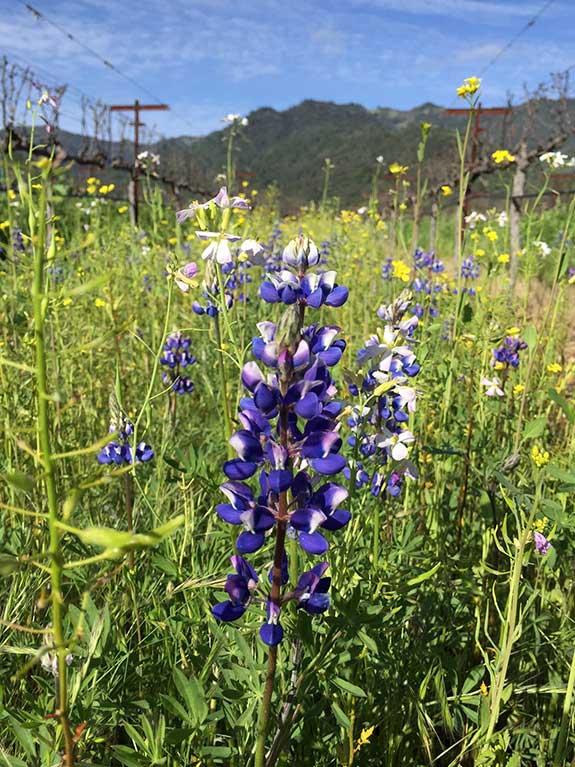
The Grape Leaf
In many stories there is an unsung hero without which the story would never be resolved and the main hero would never save the day. Now I'm not saying that a cluster of grapes is anyone's version of Batman but in the vineyard we do have our own unsung hero, the grape leaf.
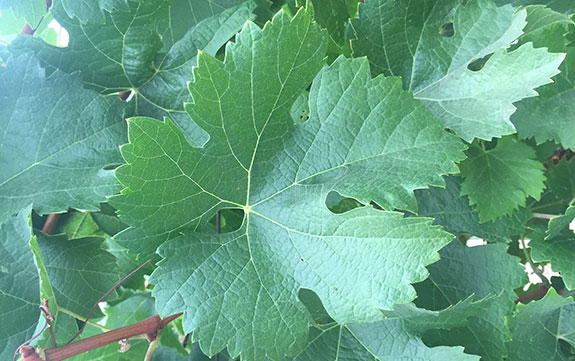
The truth is, the majority of what the vineyard team does revolves around the grape leaf. Sometime we are sampling them to see what nutrients are in the plants, we are constantly monitoring them to see if mites or leafhoppers are affecting their ability to photosynthesize and our crew is frequently going in to take off certain leaves in order to let in more air and sunlight to the fruit. We even monitor water stress by the look of the foliage and we control the canopy's power by hedging the shoot tips.
We focus so much time and energy on the leaves because the leaves are the true powerhouses behind tasty wine. It is the leaves that have the ability to capture sunlight using the green pigment called chlorophyll in order to generate the energy needed to transform carbon dioxide and water into sugar during the process of photosynthesis. This is why mature leaves are called the Sources, because they are the source of the energy for the plant. Grapes and immature leaves are considered Sinks because energy (sugars) produced by the sources are sunk into them so that they can grow and mature. All leaves begin their lives as Sinks because they need energy in order to build the internal machinery they will use to be a contributing member of the canopy. The leaf's job is to make sure that the clusters ripen and our job in the vineyard is to protect and help them to make our grapes perfect for the Winemakers.
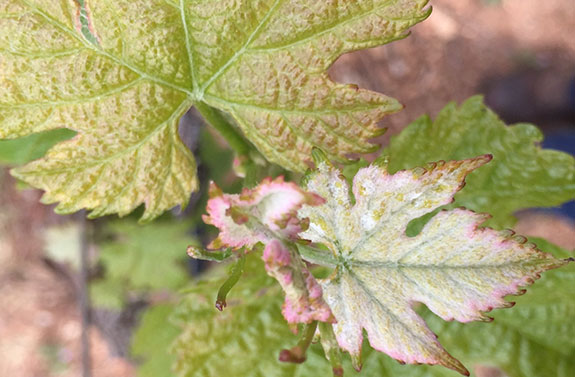
The Tools of Harvest
Harvest is such an exciting and high energy time of the year. During this time there are some very important tools that we use in order to safely and efficiently harvest all the grapes over a 2-3 month period. Here are some of the Vineyard Team's most important tools:
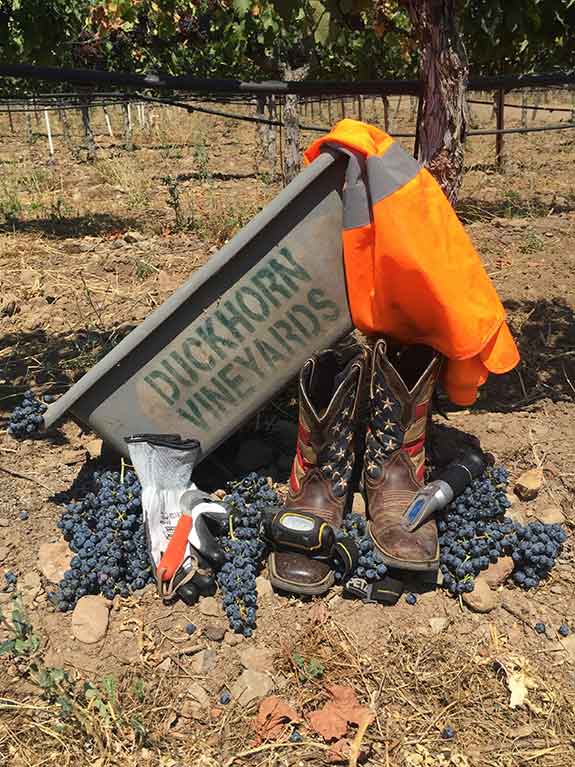
Picking pan/lug:
This grey box is important for hand harvesting fruit. Our harvesting crews use these lugs to pick fruit into. Once they fill up one of these they dump it into a bigger bin that gets transported to the winery.
Gloves/ Safety Vest:
The cut resistant gloves and bright orange safety vest are very important for keeping the crews safe and visible!
Boots:
A good pair of reliable, warm and comfortable boots make the long work hours so much easier!
Headlamp:
The majority of our harvesting is performed at night and although we have large, overhead spotlights to make the area we are picking bright as day it still helps for the guys to have headlamps so that they can see the fruit perfectly with no shadows.
Picking knife:
This is the tool that each harvester uses to cut each cluster from the canes.
Refractometer:
While it is our Winemaker and her taste buds who decides when the fruit is at the optimal maturity to harvest, we in the vineyards use a refractometer to run quick tests to assess if the sugar content in the fruit is at a point where it needs to be sampled more extensively by the Winemaker.
Happy Harvest!
Duckhorn Vineyards: The Founding
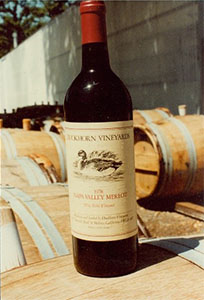 Duckhorn Vineyards was founded in 1976 by Dan and Margaret Duckhorn. After taking a trip to Pomerol in the mid-70’s, and tasting some of the Merlot-influenced “Right-Bank” Bordeaux wines, Dan met up with Ric Forman. Ric was the winemaker at Sterling Vineyards at the time and when he heard that Dan was looking for some Merlot, he gave him a call – “I’ve got a vineyard you have to see”.
Duckhorn Vineyards was founded in 1976 by Dan and Margaret Duckhorn. After taking a trip to Pomerol in the mid-70’s, and tasting some of the Merlot-influenced “Right-Bank” Bordeaux wines, Dan met up with Ric Forman. Ric was the winemaker at Sterling Vineyards at the time and when he heard that Dan was looking for some Merlot, he gave him a call – “I’ve got a vineyard you have to see”.
The two met up, and Ric took Dan up to the Three Palms Vineyard in Calistoga. Besides the gift of introducing Dan to Three Palms Vineyard fruit, Ric also recommended a winemaker by the name of Tom Rinaldi. When Tom rolled up to the winery on a motorcycle looking like “a flower child” as Margaret Duckhorn called him, they had no idea what they were in for. It worked out perfectly because Tom ended up as the Duckhorn winemaker for the next 20 years.
The early days of winemaking were simple with only three stainless steel tanks under a big oak tree and hand cranked basket presses. 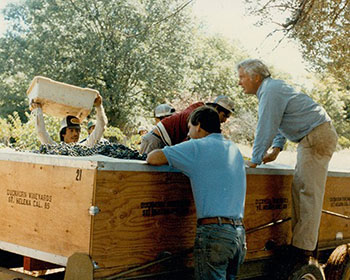 For the first vintage in 1978, they only harvested 28 tons of grapes into apple lug boxes, half Cabernet Sauvignon and half Merlot. Everything was handpicked and sorted extensively. Dan’s trip to France had also introduced him to the Nadalie family who were barrel builders and he decided that brand new French oak was the way to go. Those first few vintages were cellared exclusively in Nadalie coopered barrels.
For the first vintage in 1978, they only harvested 28 tons of grapes into apple lug boxes, half Cabernet Sauvignon and half Merlot. Everything was handpicked and sorted extensively. Dan’s trip to France had also introduced him to the Nadalie family who were barrel builders and he decided that brand new French oak was the way to go. Those first few vintages were cellared exclusively in Nadalie coopered barrels.
By 1982 Tom and Dan decided that it was time to make Duckhorn’s first white varietal wine, Sauvignon Blanc. The Sauvignon Blanc was an exciting addition for them because it was a brand new wine for them to create. With the expansion of the winemaking program came a need for more fruit, this is when Duckhorn began acquiring some of the properties that are still so important today. Two of the early vineyards purchased were Patzimaro Vineyard in 1989 and Monitor Ledge Vineyard in 1992. Now, 40 years after being founded Dan’s dream of having his wine served in every city with an NFL team has been realized!
